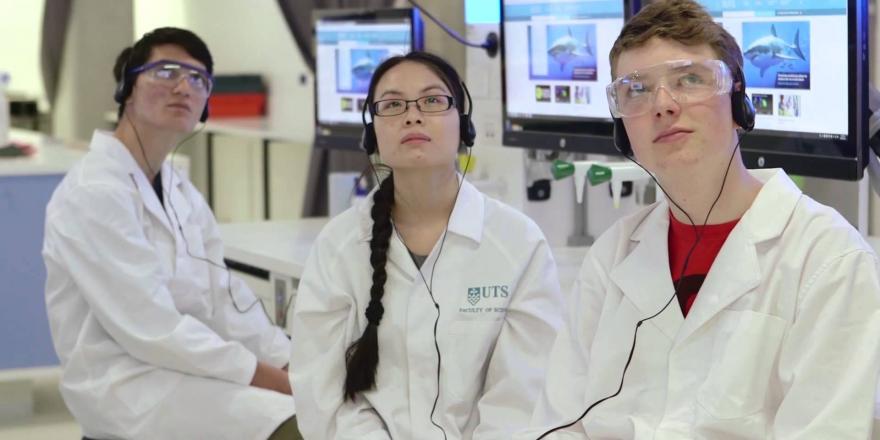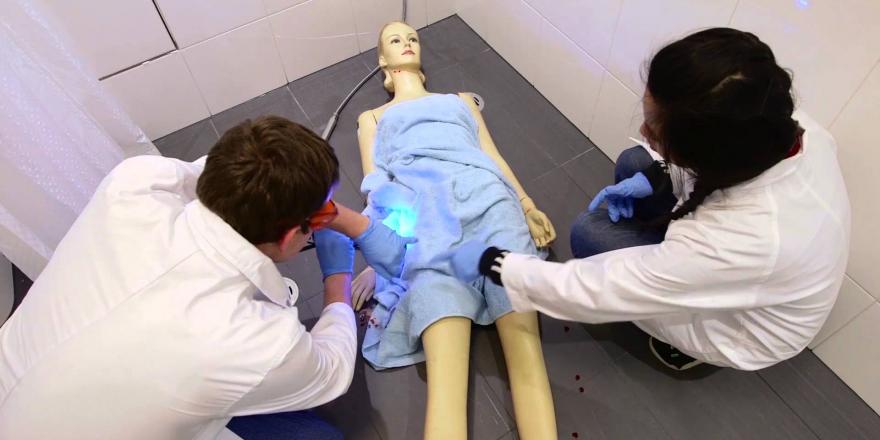UTS Science is located on the UTS City Campus in the heart of Sydney.
Teaching and learning facilities
UTS has invested over $110 million to its science facilities, making it one of the best in Australia. Students gain access to specialised advanced laboratories containing state-of-the art equipment and instruments used in research, industry and commercially, for example in chemical or diagnostic analysis or biological imaging.
By providing access to state-of-the-art facilities and equipment, our students and researchers not only gain essential experience in using such equipment, but they are provided with the facilities needed to produce credible research.
Vicki Sara Building (Building 7)

The Vicki Sara Building (Building 7) offers research, teaching, learning, and social spaces for the faculty, as well as general teaching spaces and public areas for the general UTS community.
Overlooking Alumni Green, the new building is connected to the adjacent UTS Science Building, while also providing pedestrian connections to Thomas Street.
UTS Science has 15 teaching laboratories dedicated to teaching and learning. Each laboratory is fitted with modern scientific and analytical instruments, electronic lecterns and computers. Modern computer labs with 24/7 access, advanced computing facilities with the latest mathematical and statistical software are also available to assist with student work and learning.
Hive Superlab

Each coloured section within Hive Superlab is a distinct zone, allowing multiple classes to run in tandem
The underground Hive Superlab takes its name from hexagonal features designed to create an interactive ‘buzz’. Again, collaboration is the focus of this world-class teaching lab, which holds up to 270 students. Each coloured space is a distinct zone with specialist AV, including bone-conduction headphones that let lab-users hear their facilitator but also carry on conversations with peers. Up to seven classes can run simultaneously, allowing students from different disciplines to learn side by side. This creates opportunities for cross-discipline collaboration and cross-pollination of knowledge and ideas.
The Hive is a step up from our existing Building 7 Superlab, both in size and in the types of experiments it can accommodate. Designed to a PC2-standard, it will allow our students to get hands-on – or gloves-on – experience with a broad range of biological materials that could include food poisoning organisms like pathogenic E. coli and Salmonella, and organisms that can cause serious infections like golden staph.
Science Super Lab

The UTS: Science Super Lab is the first of its kind in Australia. Featuring modern equipment and technology it can accommodate up to 220 students from 12 different classes, with experiments from different disciplines running at once. This short video provides a detailed look into a day in the life of the Super Lab.
[Instrumental music]
A unique facility
[Opening shot panning across students using computers at work benches]
52 metres long
26 workbenches
12 demonstrator stations
[Close up shot of Super Lab computers panning out to view entire lab]
Break out sections
Lots of natural light
[Shot of four tables in a break out section with students sitting at tables watching smart board, a demonstrator in a blue lab coat talks students through content on smart board]
[High shot overlooking Super Lab full of students all wearing white lab coasts working at benches with computers]
12 different classes
220 students
Learning simultaneously
[close up of three students in white lab coats with headphones on looking at computers and writing]
[Demonstrator wearing blue lab coat puts headphones on]
Two-way wireless headset and microphone communication]
[close up of student plugging headset cord into receiver; and then putting headphone set on head]
Sophisticated and easy to use
[Demonstrator wearing blue lab coat touches computer monitor; students at work benches follow on their own computers]
Video streaming to students’ PCs
[close up of student wearing headphones looking at computer]
12 LCD screens
[Diagrams are projected on to large LCD screen as students watch]
Document and PC Projection
[Demonstrator in blue lab coast talks and students look at LCD screen]
[Physics student in white lab coat and clear safety glasses opens drawer at workstation pulls out keyboard talks to two other students while looking at PC]
Surface Pro tablet and wireless camera
[Student touches computer monitor to enlarge graph]
[Students look at computer and notebook discussing problem]
[a button is pressed which changes a blue light at their workstation to orange]
Orange lights alert demonstrators to students
[Light turns orange and a demonstrator in a blue lab coat and clear safety glasses comes to students to assist]
Students are well supported
[Demonstrator continues to talk to group of students who nod their heads]
[Close up of students in white lab coats picking up test tube with red chemical out of fume cupboard]
[Demonstrator in blue lab coat points to test tube and talks to student in white lab coat]
Our Science Super Lab is one of only two in Australia. It has been modelled on the Super Lab at London Metropolitan University. The design has been adapted to meet the specific requirements of the Faculty of Science.
The lab consists of 25 workbenches, each sitting eight students. Each student has a monitor in front of them which will show a combination of information from the demonstrator station as well student’s own data input from their bench computer. There is also around 60 breakout spaces, some equipped with smart boards, for group discussions and student presentations.
For more information about the Super Lab, visit City Campus Master Plan.
Crime Scene Simulation Lab

Forensic students at UTS Science have access to a unique Crime Scene Simulation Lab. Set up like a city apartment, the lab provides students with practical experience in crime scene investigations.
[Instrumental music]
[Close up of someone in lab coat scanning pass and opening door, then close up of sign that says Crime Scene Simulation Lab.]
[Forensic student in mock dining room dusts for fingerprints; student in mock lounge room takes a photo of evidence.]
Custom designed virtual city apartment
[Three forensic students sit at bench with three computers examining photos of evidence and discussing findings.]
Training aspiring forensic scientists and crime scene investigators
[Close up of students discussing photos.]
Simulating real-life crimes
[A forensics student measures the length of a suspect’s shoe; close up of a suspect’s shoe with a tape measure next to it]
Break and enter
[The forensic student takes a photo suspect’s shoe in mock break enter crime scene.]
Suspicious circumstance
[Two forensic students in a mock bedroom remove covers from bed where a dummy body lays.]
Everyday settings where crimes typically occur
[Two forensic students in mock crime scene in dining room dust a glass for finger prints and use a blue light to examine evidence.]
Teaching fingerprint detection
[Close up of student dusting dining room table for finger prints.]
[Student rolls out yellow crime scene tape over mock bathroom crime scene while another student uses a blue light to look for evidence.]
Detecting blood hidden in crime scenes
[Second student joins one in bathroom as blue light shows mock blood in crime scene.]
[Close up to student in bedroom scene collecting evidence]
[Two students in mock study crime scene with dummy body look for evidence]
Working collaboratively
[Close up of waste bin where student finds gun and places into evidence bag.]
[Second student uses magnifying glass and takes notes.]
Developing new detection methods
[Kitchen shows mock drug lab where two students take photos and collecting evidence]
New human identification techniques
[Close up of student taking a swab of substance in glass container]
World leading forensics education
[Close up of student in mock bedroom looking at brochures and cards left on floor]
Forensic Science students at UTS have access to a unique Crime Scene Simulation Lab. Set up like a city apartment, the lab provides students with practical experience in crime scene investigations.
Mathematics and computing facilities

Students studying mathematics and statistics are supported with current mathematical and statistical software, modern computer labs with 24/7 access, e-learning support, regional and national advanced computing facilities, and peer-mentoring.
Our mathematicians and statisticians work together with businesses to provide advice and solutions. It is also one of the founders, and equity holder of ac3, a private company that manages IT infrastructure and also looks after supercomputers that are jointly owned by NSW Universities. Students will gain access to these machines which are essential to research, providing you with world class facilities.
